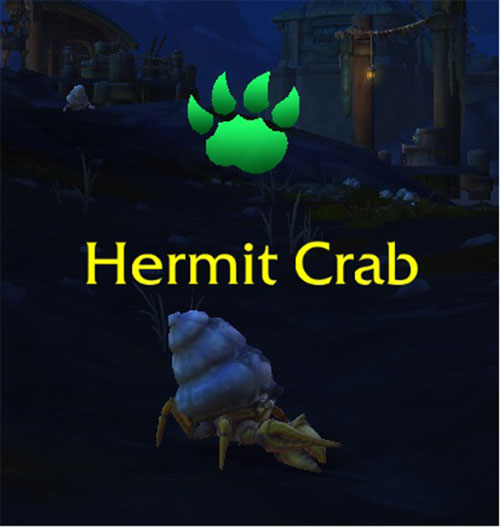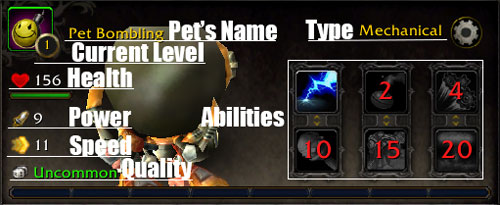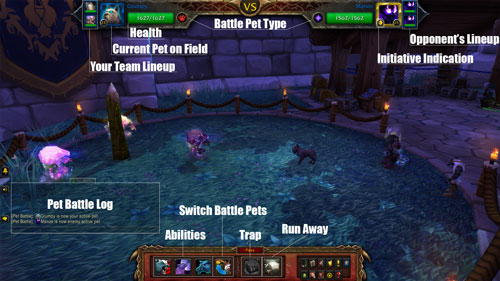Back in 2012, the Mist of Pandaria expansion brought with it a new mini game for players to take part in. In the past, passive companion pets were collected for purely cosmetic reasons. Today a large majority of these companions can be pitted against Wild Battle Pets, NPC trainers, and other players in PvP matches.
If you are new to WoW Battle Pet Combat, this article will tell you all there is to know to getting started in this fun and strategic mini game.
Getting Started
First and foremost, your character needs to be of at least level 5 in order to learn the Battle Pet Training skill. In each of the starting cities there is a Battle Pet Trainer that will teach you the skill for 10g. This price is affected by reputation, so if you have a brand new account, you may want to consider waiting a bit before spending all that money so early on. Once unlocked, it is an account wide skill and only needs to be bought just the once.
Along with this new skill, the trainer can also teach you your race’s specific starter pet.
Alliance Races
- Draenei – Blue Moth
- Dwarf & Gnome – Snowshoe Rabbit
- Human – Orange Tabby Cat
- Night Elf – Great Horned Owl
- Worgen – Gilnean Raven
Neutral
- Pandaren – Jade Crane Chick
Horde Races
- Blood Elf – Golden Dragonhawk Hatchling
- Goblin – Shore Crawler
- Orc & Troll – Black Kingsnake
- Tauren – Brown Prairie Dog
- Forasken – Undercity Cockroach
All Battle Pets are account bound, so once unlocked they are available for each of your characters. One way to start building your collection, is to create a new character for each available Battle Pet, learn that race’s pet and then either keep or delete the character.
Alternatively, these pets can be purchased off of vendors in or around the factions capitals, or off the Auction House.
With your new Battle Pet(s) in tow, you can now take part in glorious pet battles.
Building Your Team Roster
Begin by opening your pet tab with (Shift+P), and select the pet tab at the bottom of the page. You will notice that there’s only one active slot. To build your roster and unlock the remaining two slots, you will need to complete two basic achievements.
First, drag the desired pet’s icon from the list on the left, over to the empty slot. By earning exp through pet battles, you will be able to achieve the first Achievement “Newbie” – By simply raising a pet to level 3.
Not only will this unlock the 2nd slot, you will also gain the ability to trap wild battle pets. Continue to battle away and bring your pet to level 5, to unlock the “Just a Pup” achievement and the 3rd and final slot, thus granting you a full team roster.
Collecting Battle Pets
Aside from spending money on new Battle Pets, the main way to collect more is by capturing them. After unlocking the Newbie achievement, you will gain the ability to capture Wild Battle Pets during a battle. To do this, you will firstly need to bring them down to below 35% of their maximum health. The trap icon will turn from dull gray to colorful, indicating that there is a chance for you to capture the pet you are currently fighting.
We use the word chance, as there is a possibility that you will miss. Each attempt forfeits an action on your turn leaving your current pet open for an attack. If your attempt fails to capture the target, it is free to continue its turn and it may actually knock your pet out cold. In the event that you have no more pets left standing, the battle is lost and the target escapes. If your attempt fails, and the target does not knock out your pets, then the next time you try to capture it, your chances are increased, and continue to increase until you either succeed, or it knocks out your team.
Alternatively, Battle Pets can be gained through quests, achievements, or as items dropped from various mobs and boss encounters.
Hunting Wild Battle Pets
Finding wild Battle Pets is as easy as clicking a button. On the mini map located in the top right corner of your screen, there is a magnifying glass. Clicking on this icon and selecting Track Pets, will enable Wild Battle Pets to appear on your mini map, as indicated with the green paw icons.
![]()
Not only does this highlight the nearby pets on your mini map, it also places the battle pet icon above the critters that you can engage. Critters that do not have the icon above their heads, can not be battled.

Gotta Catch’em All!
There are over 500 different Pokemon, I mean Battle Pets to collect. Each zone has a list of specific Wild Battle Pets that you can encounter. As you build up your collection, each time you encounter a battle pet, hovering over it lets you know if you already have it in your collection, and if so how many.
At most, you can only collect 3 of each Battle Pet, with only one counting towards the collection achievements. Technically speaking, there are even more Battle Pets then what are listed in game. Though it is not clearly defined or explained in game, there are also different breeds available for most pets, and varying qualities.
Breeds and Qualities
Breed – Is determined by the highest stat of the three stats the pet has. This mean that you could collect three of the same battle pet and all three could have different stat values. The only in game way to see which breed you have, is to compare its stats against an equally leveled pet of the same quality. Another way to tell is by downloading the Battle Pet BreedID Add-on from wow.curseforge.com.
If you have never installed an Add-on before, please read our helpful step by step guide on How to Correctly Install Add-ons.
As for quality, there are four varying qualities, each one stronger then the last:
- Poor
- Common
- Uncommon
- Rare
Quality rarity has no impact on the type of abilities that the pet has, it affects the base stats. Four pets of the same breed, will have weaker stats the lower its quality. At low levels, this difference in only minor, but as you increase their level, the gap becomes a lot wider.
There are items that can be gained through completing quests, or purchased off of pet trainers, that can improve the pet’s current quality.
Understanding Your Battle Pets

Clicking on your battle pet’s icon, brings up their info panel. Their current level is found next to their icon in the top left corner. The bar along the bottom is the exp bar, indicating how close they are to leveling.
In the top right-hand corner, you can find the pet’s type. This is important to take note of, as each type has its strengths and weaknesses.
Along the top on the left is the pet’s current name. You can customize this by right clicking on the pets icon and selecting rename.
In the lower left corner you can see the pet’s current quality.
Stats
On the left-hand side of the panel, there are three stats:
- Health: Indicates the pets Maximum Hp when full, and their current Hp when damaged. Reaching zero Hp will render your pet unconscious until it is revived.
- Power: This indicates how much damage and healing is down by the pets abilities. The lower the value the weaker its abilities will be.
- Speed: At the start of each battle/round, the pet with the highest speed value will gain initiative, and take their turn first.
Abilities
On the right-hand side of the panel, you can find the pets currently available abilities. These abilities are level gated. The first being available at level 1, and unlocking more abilities at levels: 2, 4, 10, 15, and 20. As your pet unlocks its 2nd tier abilities, it can swap them out with the ability directly above it.
During battle, each pet is limited to a using just three of its abilities, making strategic planning with the rest of your line up important. Some pets offer support, or buffs/duffs, making many pets more versatile.
The Different Pet/Attack Types
Think of pet types as being a game of rock, paper, scissors. There are a total of 10 different types of pets. Instead of being weak or strong against the various pet types, each type is either vulnerable to, or resistant against the different types of attacks.
Not all pets are limited to using the same attack type as their pet type. As such this can make it a little tricky to follow. Each type does have it’s own passive abilities, strengths and weaknesses, so for your convenience, we have made you a helpful reference table. It shows each type’s passive abilities, and what they are stronger against, and vulnerable to.
Battle Pet Type |
Battle Pet Passive Abilities |
Strong Against |
Vulnerable Against |
||
|
Bonus |
Resistance | Weakened | Lower | ||
| Damage | Bonus | Attacks | Defense | ||
| +50% | +33% | -33% |
-50% |
||
 |
Harmful damage over time effects are reduced by 50% on Aquatic pets. | ||||
 |
Beats deal 25% extra damage below half health. | ||||
 |
Critters are immune to roots, stuns, and sleep effects. | ||||
 |
Dragons deal 50% additional damage on the next round after bringing a target’s health below 50%. | ||||
 |
Elementals ignore negative weather effects. | ||||
 |
Flying creatures gain 50% extra speed while above 50% health. | ||||
 |
Humanoids recover 4% of their maximum health, if they dealt damage this round. | ||||
 |
Magic pets cannot be dealt more than 35% of their maximum health in one attack. | ||||
 |
Mechanical pets come back to life once per battle, returning to 25% health. | ||||
 |
Undead pets return to life, immortal for one round then killed. | ||||
Understanding Combat

Battle Pets take turns in performing their chosen actions. Known as initiation, the pet with the highest speed stat is the pet that takes their action first. Some pets have abilities with turn based cooldowns, others may take x amount of turns to proc, and some even last for a set amount of turns.

Get familiar with your pet’s abilities and their mechanics, to help you determine not only how to use them in battle, but when to use the abilities as well. Any none combative action such as swapping out a pet, or attempting to capture a Wild Battle Pet, will use an action, forgoing any attacks that round.
Some abilities can cause targeted status affects, in the form of buffs and debuffs, or even abilities that effect the field as a whole. Such effects and even doomsday countdown timers will affect the team to which it appears under. If an affect appears in the center of the bar, it effects both teams and offers positive or negative effects, that count alter the outcome of the battle.
